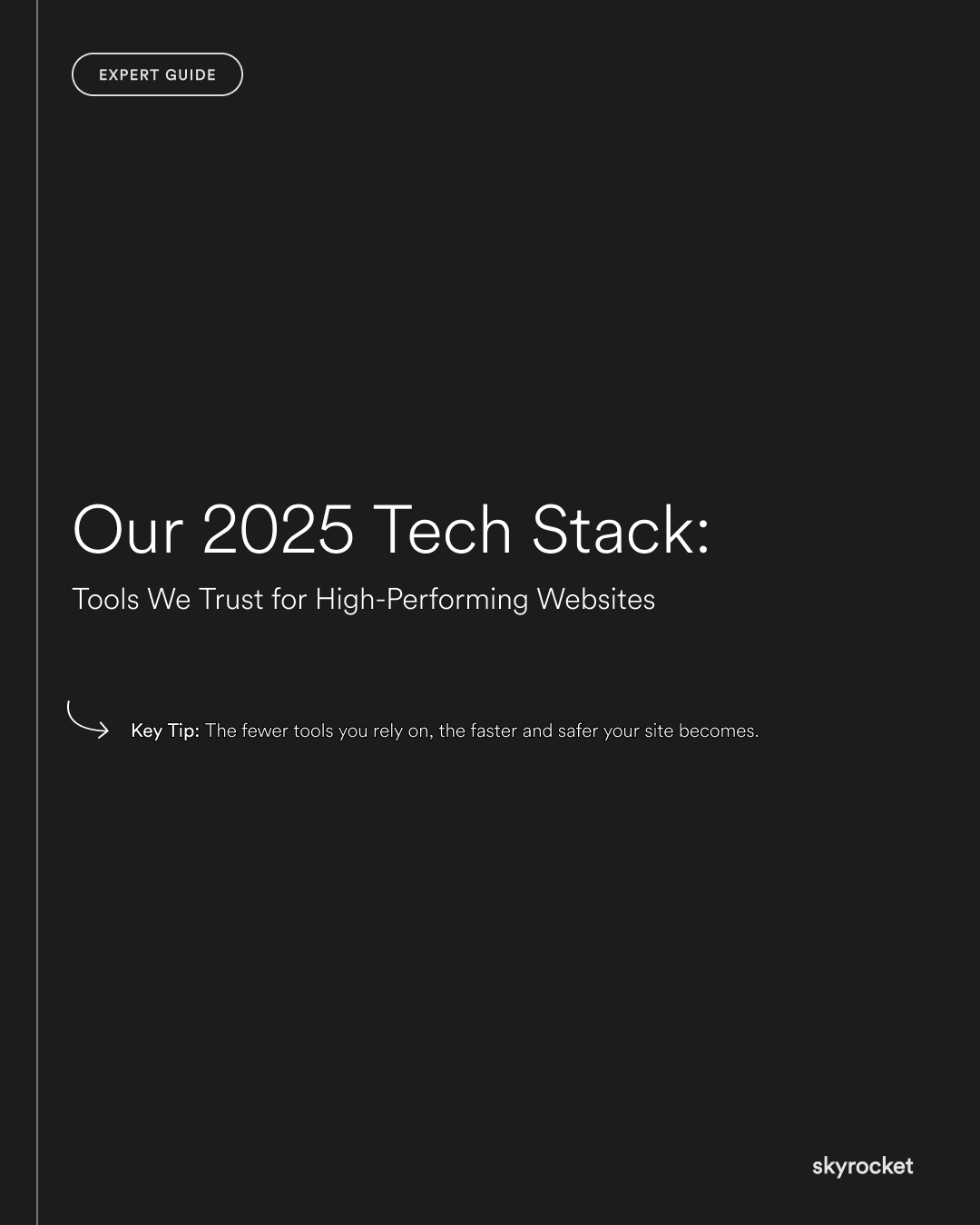If you are building or running a business website, the tools behind it matter more than most people realise. The wrong choices can make your site slow, fragile, and hard to update. The right stack keeps your site fast, scalable, and easy for your team to manage. In 2025, there are more tools than ever, but more options also mean more noise.
This guide takes you inside the tech stack we trust for building high-performing websites. It will help you understand why each tool matters, what role it plays in business outcomes, and how to avoid the pitfalls of bloated or outdated setups.
Why This Matters in Business Terms
The tech you choose is not a backroom decision. It affects your business directly:
- Sales: Slow sites lose conversions. Studies show a one-second delay can cost 7 percent of revenue.
- Growth: A solid stack scales as you expand, so you do not need to rebuild every time you add products or campaigns.
- Trust: A reliable, professional site builds credibility. Downtime and glitches chip away at confidence.
- Efficiency: Good tools reduce wasted hours. Your team spends less time fixing and more time growing.
Key Tip: The fewer tools you rely on, the faster and safer your site becomes. Many businesses assume more plugins or apps means more power. In practice, every extra tool adds risk. A lean stack built on strong core platforms nearly always outperforms a bloated one.
The 2025 Tech Stack We Trust
1. Webflow for Websites
Webflow is our go-to for business websites that need custom design with simple editing. It lets marketing teams publish and update content without waiting on developers. Sites built on Webflow are fast, secure, and flexible enough to handle campaigns, blogs, and landing pages.
Why it matters for business:
- Faster time to market for campaigns
- Lower ongoing maintenance costs
- Clean code and hosting built in
2. Shopify for Ecommerce
When the focus is selling online, Shopify leads. It provides a stable, scalable foundation with payments, inventory, and shipping handled natively. Unlike DIY plugins, Shopify gives reliability and security out of the box.
Why it matters for business:
- Reliable checkout experience boosts conversions
- Scales easily for NZ and international customers
- Less downtime and fewer bugs than plugin-heavy platforms
3. Figma for Design and Collaboration
Figma is where design comes together. It allows real-time collaboration between designers, developers, and clients. Having one source of truth prevents miscommunication and wasted rounds of edits.
Why it matters for business:
- Clearer feedback cycles
- Faster design approvals
- Better consistency across brand assets
4. Slack for Communication
Slack keeps project communication out of email. Quick questions, file sharing, and integrations with other tools mean projects move faster.
Why it matters for business:
- Reduces delays caused by email threads
- Keeps conversations searchable and transparent
- Connects with tools like Google Drive and Figma
5. Dropbox for File Management
A reliable file storage system matters more than you think. Dropbox provides a central, secure place for all project files.
Why it matters for business:
- Keeps assets backed up and accessible
- Prevents version confusion
- Secure sharing with clients and partners
6. Bonsai for Contracts and Invoicing
Clear agreements and smooth invoicing are part of keeping projects on track. Bonsai simplifies proposals, contracts, and payments in one tool.
Why it matters for business:
- Faster project kick-offs
- Reduced admin time
- Transparent, professional process
7. Google Workspace for Everyday Operations
Docs, Sheets, Gmail, and Drive form the backbone of daily work. They keep the team aligned and make collaboration simple.
Why it matters for business:
- Shared documents reduce duplication
- Easy collaboration in real time
- Reliable and familiar tools for most teams
Common Objections
“Can’t we just add more plugins to do the same thing?”
You can, but each plugin creates another point of failure. More moving parts mean more ways for your site to break.
“Isn’t Webflow or Shopify more expensive than DIY?”
The upfront cost might be higher, but over time you save on maintenance, fixes, and lost sales. A strong core platform pays for itself.
“Do we really need all these tools?”
Not necessarily. The point is not to copy a list but to choose a small set of reliable tools that work together and fit your needs.
“Our current setup works fine, why change?”
It may be fine now, but old or patchwork systems often fail when you scale. Switching before you hit the wall is cheaper and less stressful.
Here’s an Example to Make This Real
Company: Harbour Home, a NZ furniture retailer.
Before: Their site was built on WordPress with multiple plugins for ecommerce, design tweaks, and forms. It was slow, buggy, and expensive to maintain.
What they did:
- Migrated ecommerce to Shopify
- Rebuilt content pages in Webflow
- Used Figma for brand refresh
- Shifted communication to Slack for faster project flow
Result: Site speed doubled, customer trust improved, and the team cut admin hours in half. Sales rose steadily thanks to a more stable online experience.
What to Do Now: Your Checklist
- Audit your current tools: List what you use and how often it causes issues.
- Cut redundancies: Remove plugins or tools that duplicate each other.
- Choose strong core platforms: Pick reliable systems that scale with you.
- Keep it lean: Resist the temptation to add unnecessary extras.
- Plan for growth: Make sure your stack can handle the next three years, not just today.
Want to Talk It Through?
If you are unsure whether your current tools are helping or holding you back, we are happy to chat. Sometimes a fresh perspective on your tech stack is all you need to simplify and strengthen it.



